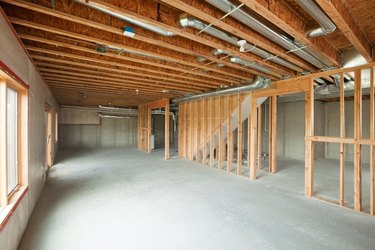
If you have a heating, ventilation, and air conditioning (HVAC) system, the heated or cooled air is distributed throughout your home via a ductwork system. Ducting in residential buildings is generally made from sheet metal that is insulated. Insulation is measured using an R-value. The "R" refers to a unit of thermal resistance.
The higher the R-value, the better the insulation provided by the ducting. Most ducting used in homes is insulated and is categorized as R6 ducting or R8 ducting. There are pros and cons for both types of ducting.
Video of the Day
Video of the Day
R-Value and Ducting
R-value refers to the duct insulation's effectiveness when it comes to resisting heat conduction. This means that the R-value measures the effectiveness of the insulation material. The higher the R-value, the more effectively the insulation material insulates. A higher R-value is important in cold climates where temperatures dip below freezing. Factors that influence R-value include composition of the insulation material, its density, and how thick it is.
Comparison of R8 and R6
A variety of differences exist between R8 and R6 ducting. R8 ducting is composed of thicker insulation than R6 ducting. That means if you have R8 ducting in your HVAC system, your ducting is better insulated than if it consists of R6 ducting.
R8 ducting is more efficient at heat insulation than R6 ducting. R8 ducting reduces energy loss by about 2 percent. This results in consuming 3 percent less energy. That means your energy bills will be lower if your home has R8 ductwork.
When it comes to costs, R6 ducting is less expensive. Because R8 ducting is wider in diameter, it will cost more. If your home is large, you could pay substantially more for R8 ducting. R6 ducting has a smaller exterior than R8 ducting, is more flexible, and fits into tighter spaces.
If you decide to upgrade from R6 to R8 at a later date, it may not be possible. R8 ducting is thicker, and it may not work well because of the difference in diameter. That can cause problems, including noisy ductwork. Additionally, R8 ducting may not fit in tight spaces.
Choosing the Best Ducting Type
When choosing the best R-value ducting for your home, there are some primary considerations. The first is climate. If your home is located in a cold climate, you will want a minimum of R8 ducting. In the attic space, it could even run as high as R11. Homes in mixed climates and warm climates can use lower R-value ducting, but R6 or R8 is still generally advised.
The location of the ducting in your home also needs to be taken into consideration. If the space is tight, R8 may not fit. In that case, you'll have to go with R6, which is smaller in diameter.
Check Local Building Codes
Before installing ducting in your home, it's important to check your local building codes. Most areas have basic requirements for new installations and structures. Some areas also have requirements for retrofitting. It is likely that if you live in a cold climate, you will be required to use R8 ducting for your home's HVAC system. Check with a building contractor about the best R-value of ducting to use in your home.